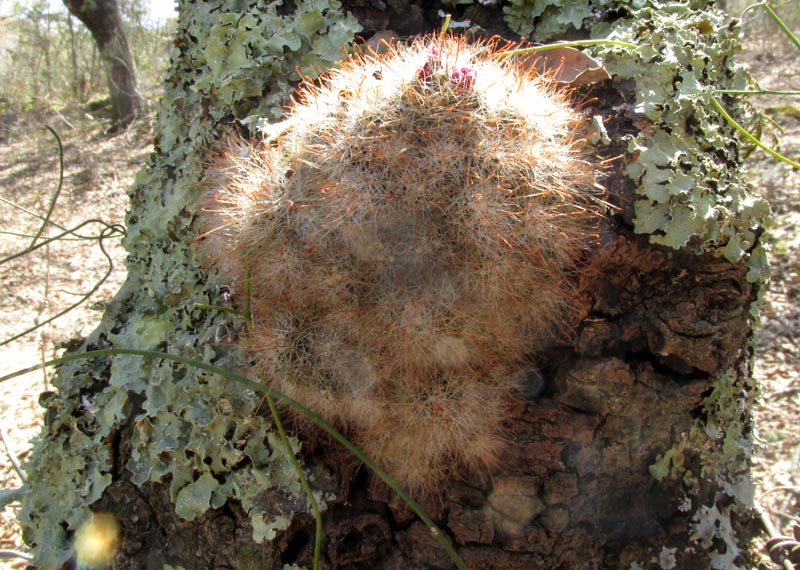Excerpts from Jim Conrad's
Naturalist Newsletter
entry from field notes dated April 15, 2022, taken in disturbed/reforesting borderline cloudforest within 1km of Valle de los Fantasmas, elevation ±2,320m (7600 ft), with limestone bedrock; about 40kms (24 miles), straight-line, ESE of San Luis Potosí, San Luis Potosí state, MÉXICO, (N22.06°, W100.62°)
MAMMILLARIA ERYTHROSPERMA ON A FENCEPOST

Along a mostly shaded, overgrown, one-lane dirt road following the floor of a sheltered valley, a lichen-covered fencepost beside the road was made from a small treetrunk with its top cut off. The fencepost had a cavity near its top, and the above cactus grew snugly in the hole. Despite the dense covering of hairs and spines, it was clear that this was a mammillaria cactus, genus Mammillaria, one of the largest genera in the Cactus Family, with about 200 known species, most of them native to Mexico. Mammillarias are recognized by their green bodies consisting of clustered round-topped parts, with the body looking like a bunch of chili peppers with their rounded bottoms pointed outward.
Though this particular species was so heavily coated with hairs and spines that the individual parts, or "tubercles" when referring to cacti, couldn't be seen, the shadowy areas between the tubercles more or less revealed the tubercles' presence. Also, mammillaria cacti normally are more or less spherical, with lots of spines per tubercle. However, every mammillaria I've ever seen grew on the ground, not as an epiphyte. While I was photographing the cactus, a man leading a cow came along and I asked him whether he thought the cactus was naturally growing on the post, or if someone had placed it there. He said it grew there naturally, and that such cacti could be seen growing both on trees and the ground. I'm not sure he's right, but that's what he said.
Fortunately the cactus bore flower buds just beginning to open, so the corolla color could be noted, shown below:

That photo also shows the very important feature of the larger, hooked spines being pale brown, while the more numerous, thinner and hairlike spines are white. Below, a picture of spine clusters at the body bottom gives a better idea of how the brown, hooked spines relate to the white ones:

The stouter, brown, hooked spines arise from each cluster's center, while the more numerous, thinner, hair-like spines radiate from around the hooked spines' bases. It's hard to say, but I count about 16 white, thin spines radiating from around the base of each brown, hooked spine.
Mammillaria identification depends a lot on the color of sap produced when the body is wounded, and the diameter of the tubercles. I wasn't about to hurt the plant or remove its hairs and spines so I could measure a tubercle, so in the end I had to search photos of mammillaria cacti found in San Luis Potosí state, which is an awkward way to get a dependable identification. Eventually, however, some pictures matching our plant came up and, since our plant is so unusually hairy/spiny with those brown hooked spines.
*UPDATE: Those pictures lead me to an ID, Mammillaria bocasana, which apparently was wrong. In 2024 the pictures were uploaded to iNaturalist, where user "jonathanmohl," a collector of Mammillaria species for over 15 years, and an iNaturalist curator, recognized MAMMILLARIA ERYTHROSPERMA, a narrowly endemic species in upland central Mexico, mainly in this part of San Luis Potosí state. That species looks as much like the one in our pictures as did Mammillaria bocasana, and I have more confidence in the experience of "jonathanmohl" that I do my own.